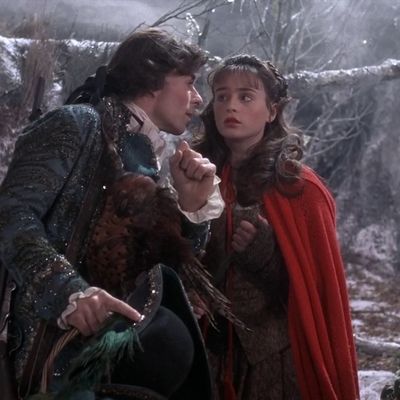
When Disney started adapting Stephen SondheimÔÇÖs Into the Woods for film, few issues were more pressing than what to do about ÔÇ£Hello, Little Girl,ÔÇØ a sexually charged duet between Little Red Riding Hood and the Wolf filled with all sorts of double entendres. Sondheim himself admitted that the studio had ÔÇ£objectionsÔÇØ to the number, and these concerns were magnified when director Rob Marshall cast an actual tween as Red. But rather than cut the song completely, the filmmakers decided instead to neuter its erotic power. They made the score a little jazzier, cut down on the physical touching, and gave Johnny DeppÔÇÖs Wolf some much-needed pants. And it worked! Like the rest of the film, the song now stays safely on the right side of the line. ItÔÇÖs creepy but never wholly inappropriate.
This was all probably necessary ÔÇö a million families were going to see Into the Woods over the holiday ÔÇö and the changes donÔÇÖt exactly ruin the story. But itÔÇÖs hard not to feel like something has been lost. Fortunately, if youÔÇÖre hankering for more exploration of the erotic undertones in the Little Red Riding Hood myth, weÔÇÖve got good news for you: There exists an entire film thatÔÇÖs just about the erotic undertones of Little Red Riding Hood, and itÔÇÖs been out for 30 years.
The Company of Wolves was only Neil Jordans second film, released in 1984, but it remains one of his most striking. (He would go on to direct The Crying Game, Interview With the Vampire, and The End of the Affair, among other movies.) Like Into the Woods, its a revisionist fairy tale; as Jordan told L.A. Weekly, Its a film about storytelling  Its about the use of stories, and in the case of fairy tales, the main use is to teach young girls not to have sex with men, isnt it? Based on short stories by British author Angela Carter (who also co-wrote the script), the films plot is a Russian doll of fables, all nestled inside each other. In a framing device, modern teen Rosaleen (Sarah Patterson) dreams shes living in a 17th-century village on the outskirts of a nightmarish forest. After her sister is killed by wolves in the woods, Dream Rosaleen begins to visit her grandmother (Angela Lansbury), who tells her a series of werewolf tales. In each, the lesson is the same: Wolves in the woods may be dangerous, but its the ones that are hairy on the inside  in other words, men  youve really got to look out for. Theyre nice as pie until theyve had their way with you, Granny warns, but once the bloom is gone, the beast comes out.
This aura of sexual menace pervades the film. In the first tale, Stephen Rea plays a young husband, a ÔÇ£traveling man,ÔÇØ on his wedding night ÔÇö when we meet him, heÔÇÖs naked in front of his bride for the first time, at once leering and vulnerable. After stepping outside to pee, he disappears; taken by wolves, his young wife thinks. Years later, after she remarries, he returns, mad with sexual jealousy. (Wolves mate for life.) He calls her a whore and attacks her, transforming into a terrifying skinless beast. ItÔÇÖs only through the timely arrival of the second husband that the wife is saved, and even that is small comfort: When she mourns the loss of the man she married, her new husband slaps her.
In another tale, a peasant woman interrupts a decadent wedding with a tale of how the groom impregnated and abandoned her. As punishment, she turns him and the entire wedding party into wolves, their debased, primal forms making a mockery of their aristocratic finery. Finally, she concludes, their outsides match their insides.
These stories are held together with the fevered logic of a dream, and that unsettling vibration carries into RosaleenÔÇÖs story as well. Filmed in BritainÔÇÖs Shepperton Studios (the same studio Into the Woods was shot in), JordanÔÇÖs woods are a truly terrifying place of lost innocence, full of eggs that crack open to reveal tiny humans and dead cows that leak bloody entrails. Even the townsfolk take on a sinister tone, like the local boy who awkwardly tries to court Rosalee. ÔÇ£HeÔÇÖs known her since she was a baby,ÔÇØ her father says, in a way that makes it clear that even that wonÔÇÖt save her.
But what might save her, Jordan and Carter conclude, is Rosalee herself. At the end of the film, they reenact the Red Riding Hood myth for real: On the way to her grandmotherÔÇÖs, Rosalee is stopped by a charming stranger (played by choreographer Micha Bergese), who challenges her to a race to grandmotherÔÇÖs house; if he wins, he gets a kiss. Just like in the fairy tale, the wolf makes it to grannyÔÇÖs first, killing and eating her. But once Rosalee arrives, the script flips. Her desire for vengeance is mixed with her desire for the wolf; she steals his gun, commands him to strip, then grants him the one kiss heÔÇÖs owed for winning the bet. Then, before he can try anything else, she shoots him. ItÔÇÖs a strange, erotic scene, filled with so many subtle power shifts itÔÇÖs almost impossible whoÔÇÖs seducing whom at any given moment. (ItÔÇÖs also fairly uncomfortable, as Patterson was only 13 when the scene was filmed.) But by the end, Rosalee is fully in control. When her father arrives to save the day, he finds two wolves sitting by the fire ÔÇö one wearing her trademark cross.
ÔÇ£The Company of Wolves is about how society teaches young women to look at themselves, and what to be afraid of,ÔÇØ Jordan said in that L.A. Weekly interview. ÔÇ£ItÔÇÖs about a girl learning that the world of sensuality and the unknown is not to be feared, that itÔÇÖs worth getting your teeth into.ÔÇØ Or, as RosaleeÔÇÖs mother puts it, ÔÇ£If thereÔÇÖs a beast in man, it meets its match in women, too.ÔÇØ


